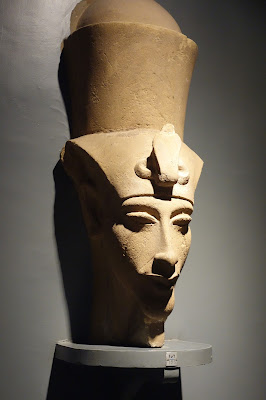Boarding the buses at 6:30 a.m. for a 13 hour adventure
came awfully early. But that’s the price you pay if you want to go from the Red Sea to Nile River and visit the town of
Luxor (aka Thebes by the Greeks) and surrounding ancient Egyptian Temples.
Miles and miles of barren mountains and sand stretched
ahead of us as we drove through the Eastern Desert. Our guide explained we were driving through
the home of the Egyptian Bedouins.
These people need to be self-sufficient. What was surprising, however, was their expertise
with natural medicine and dealing with the hazards of their environment: snakes, scorpions and the like. Small
children can be found playing with scorpions and they don’t get harmed. That’s because they are given tiny doses of
venom from cobras and scorpions as newborns (before 14 days old) as a sort of vaccination. The only poison that can’t be controlled is a
bite from the black viper. The Bedouins
leave these guys alone.
Our bus contained 22 passengers, one guide, two drivers and
one body guard. This guy had a “side arm”
about the size of a piece of firewood. I
think it was an Uzi, at least this was the consensus of people who really didn’t
know. If this wasn’t enough security,
we passed about a dozen police check points flanked by raised, enclosed
platforms containing armed “soldiers”. Riding
along I felt reasonably secure by this. Seems like the the Egyptians are serious about their three months of Marshall Law. One of the older passengers, however, claimed that all of these people were
terrorists and reacted accordingly. Funny
thing about getting old - you become both non-cognitive and incontinent at the
same time.
About 45 minutes from our scheduled arrival time at Luxor,
the desert sand was replaced by rich fertile soil and rows and rows of crops and
other vegetation. You might think this
is because of the annual flooding of the Nile, but you’d be wrong. It seems the Nile was dammed up some time
ago, resulting in a giant lake used to control of the flood waters. Now about 30 miles on both sides of the Nile there
is a system of “distributaries” that distribute the Nile water to a wide swath
of fertile ground. This coupled with an
evaporation and rain cycle continues to keep the Nile valley green.
Also, are the never ending, partially completed homes in
route. The official reason given is: as long as the home remains unfinished, no
taxes are levied. I think it has more to
do about Muslims being prohibited from borrowing money and paying
interest. Anyway, they seem to be happy,
enjoying each other, their animals and way of life.
Finally, after 3 ½ hours we made it to the Luxor ...
And the Luxor Museum.
View of the River Nile from museum plaza.
This was great, my favorite event of the day (fn from Pat – probably because it was air-conditioned … fn from Bill, no really). The artifacts and statutes of many Pharaohs including Ramses II and Amenhotep III were presented there including my favorite Pharaoh Amenhotep IV who reigned between 1352 and 1334 BCE (who BTW changed his name to Akhenaten) and his Queen, Nefertiti. Except for Madeline and other Egyptologists, a little known fact is that Akhenaten gave up Egypt’s traditional pantheon of gods and worshiped a single god, the Sun god Aten, hence the name change. This Egyptian Pharaoh, represented here with the sun disk and sun rays, may very well have been the first monotheist.
So “Roll Over Beethoven” ... and Abraham.
And the Luxor Museum.
View of the River Nile from museum plaza.
This was great, my favorite event of the day (fn from Pat – probably because it was air-conditioned … fn from Bill, no really). The artifacts and statutes of many Pharaohs including Ramses II and Amenhotep III were presented there including my favorite Pharaoh Amenhotep IV who reigned between 1352 and 1334 BCE (who BTW changed his name to Akhenaten) and his Queen, Nefertiti. Except for Madeline and other Egyptologists, a little known fact is that Akhenaten gave up Egypt’s traditional pantheon of gods and worshiped a single god, the Sun god Aten, hence the name change. This Egyptian Pharaoh, represented here with the sun disk and sun rays, may very well have been the first monotheist.
So “Roll Over Beethoven” ... and Abraham.
There are a
number of links to Hebrew / Egyptian culture / religion. One worth noting is on one of the walls at Akenhaten's capital city, Armana. There, the longest and best rendition of a
composition known as the “Hymn to Aten”
is said to have been written by Akhenaten himself. Its similarity to and possible source of the creation represented in Psalm 104 has long been noted.
It sums up the whole ethos of the Aten cult and especially the concept
that only Akhenaten had direct access to the god, Aten.
Check out the similarities. Just sayin’.
Check out the similarities. Just sayin’.
Next was a visit to the largest religious structure ever built,
the Temple of Karnak. The hieroglyphics are carved into plaster; not
chiseled into stone. Many scenes on the exterior depict the Pharaohs’
triumph over the Hebrews, Assyrians, etc. The interior scenes depict the
Pharaohs’ relation to their gods.
This was followed by The Temple of Luxor right around the
corner. Amazing day!
As I leave you we have crossed the Suez Canal and found
our way to the Mediterranean and Jerusalem for Easter.
our way to the Mediterranean and Jerusalem for Easter.
Time to say good-bye to our new southern friends and ship’s
“Auxiliary Guard.”














No comments:
Post a Comment